#constance de france
Explore tagged Tumblr posts
Text




top 10 photos taken right before disaster
translation:
“You know, Mother, that you can't trust my uncle Richard!”
“So I will not put you in his hands, my good duke.”
“But you, mother, you intend to go there?”
#panik...kalm...PANIK#it honestly feels like philippe auguste is the protag in this one...so making arthur the titular character is...an interesting choice#reading this was 80% ''oh. someone's still mad france lost the aquitaine in the 1150's'' and 10% ''[X] would NOT say that''#and 10% ''lol. lmao even.''#this is the 3rd one just because of the heavy foreshadowing that hits you like a brick when you already know what happens#*constance voice* yeah I know Richard and I don't like each other but what's he gonna do about it- order my estranged husband kidnap me?#honey.#arthur de bretagne by céline fallet#twelfth century#shakespeareomnibus#prince arthur#constance of brittany
18 notes
·
View notes
Text
Petite Friture, des luminaires design contemporains à l’esthétique frémissant !
Tout commence en 2009, avec Amélie du Passage, passionnée par le design et le beau. Elle se lance dans l’aventure et fonde Petite Friture, un éditeur de mobilier design français contemporain. Reconnu pour son ébullition créative, le label a déjà marqué le milieu du design et des luminaires, notamment avec l’emblématique suspension Vertigo. Depuis 15 ans, Petite Friture a réussi à susciter un…

View On WordPress
#éditeur de mobilier design français#Constance Guisset#design et développement durable#design production locale#icône design contemporain#lampe design français#luminaire éco-responsable#luminaire made in france#luminaire Vertigo#luminaires avec approche durable#Noé Duchaufour-Lawrance#petite friture#Suspension Vertigo#Tom Chung#Vertigo
0 notes
Text


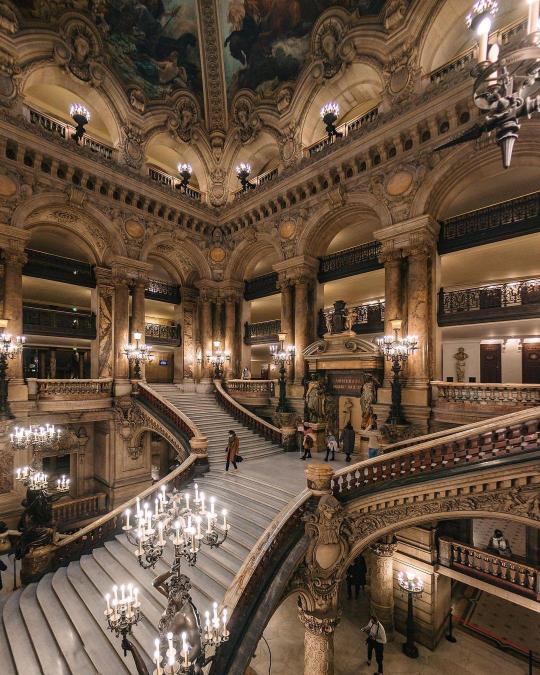




The Opera Garnier, is a renowned opera house in Paris, France. Designed by the architect Charles Garnier, it is a masterpiece of Second Empire architecture and was inaugurated in 1875. The Opera Garnier is celebrated for its opulent and ornate interiors, including the famous grand staircase, chandeliers, and Marc Chagall-painted ceiling. It continues to host ballet and opera performances and is an iconic symbol of Parisian cultural heritage.
📸: Andrea Perotta, Constance de Tourniel
#dark academia#light academia#classical#academia aesthetic#escapism#academia#books and libraries#classic literature#books#architecture#interior#design#old#historical#building#history#opera garnier#paris#france#second empire#1800s#19th century#royal core#cottage core#aesthetics#mood#vibe#tumblr#beautiful
2K notes
·
View notes
Text
The birth of Junot and Laure's first child
-From the book "La Generale Junot, Duchesse d'Abrantès, d'après ses lettres, ses papiers et son 'journal intime' inédits" by Joseph Turquan, a biography of Laure Junot featuring previously unpublished information given to the author by Georges Aubert, Junot's grandson.
The book is from 1901, and therefore is a little dated in some regards, but overall creates a good portrait of Laure and Jean-Andoche Junot.

Portrait of Josephine Junot as a little girl
Mme Junot was nearing the end of her pregnancy. It was with noble intoxication that she saw herself soon as a mother. One day, her husband entered her room and found her leaning over the cradle waiting for the little being to come: she seemed to be in ecstasy. Junot, under a somewhat harsh exterior, under the frequent brusqueness of his manners and his thoughtlessness, hid, as is often seen in these kinds of natures, a tender heart, sensitive to the joys of the family. Understanding perfectly the holy ecstasy of his wife, he embraced her with an expansiveness which added the height of happiness to she who was going to be a mother.
She had a daughter. At first she feared that this little girl would not be welcomed with as much enthusiasm as a boy. Her father-in-law, who was not very gallant, had already told her: “There was no point in crying so much to have a daughter!”
But the general did not share his father's error: he was perfect for his little wife, perfect for his little daughter and tears of tenderness showed Mme Junot that he would be the best father.*
A pain in the middle of all this happiness; Mme Junot lost her mother. If anything could bringing consolation to her grief was the thought that the poor woman was delivered from the sufferings which, for some time, had been incredibly torturing her.
Junot and his wife had asked the First Consul to be their daughter's godfather** and he had granted this favour with much good grace. The day after the baptism, which took place in Saint-Cloud and not at Malmaison which Bonaparte was beginning to abandon, Mme Bonaparte sent the young mother a necklace of fine pearls in several rows; the pearls were the size of a large gooseberry and the padlock formed by a solitaire of admirable white and water. This gift was superb, but it did not come close to that which the First Consul gave to Junot: he gave him the title deed to his hôtel on the Rue des Champs-Elysées. This was a gift of two hundred thousand francs, which increased the income of the young couple by the entire price of the rent. Instead of continuing to live on the same footing as before, which would have been just reasonable, they increased the size of the house, they decided to renew the furniture and they received more brilliantly than ever before.
*Like all men of the era, Junot wanted to have a son to continue the family line. However he showed an equal amount of love for all of his children, and when he was on campaign would send very affectionate letters and gifts to his daughters Josephine and Constance, and to his niece Clotilde.
**In addition to this the godmother was Josephine Bonaparte, who Junot's little girl was named after.
26 notes
·
View notes
Text

I decided to try this but for the girlies instead.
Are you sure want to click on ”keep reading”?
For Pauline Léon marrying Claire Lacombe’s host, see Liberty: the lives of six women in Revolutionary France (2006) by Lucy Moore, page 230
For Pauline Léon throwing a bust of Lafayette through Fréron’s window and being friends with Constance Evrard, see Pauline Léon, une républicaine révolutionnaire (2006) by Claude Guillon.
For Françoise Duplay’s sister visiting Catherine Théot, see Points de vue sur l’affaire Catherine Théot (1969) by Michel Eude, page 627.
For Anne Félicité Colombe publishing the papers of Marat and Fréron, see The women of Paris and their French Revolution (1998) by Dominique Godineau, page 382-383.
For the relationship between Simonne Evrard and Albertine Marat, see this post.
For Albertine Marat dissing Charlotte Robespierre, see F.V Raspail chez Albertine Marat (1911) by Albert Mathiez, page 663.
For Lucile Desmoulins predicting Marie-Antoinette would mount the scaffold, see the former’s diary from 1789.
For Lucile being friends with madame Boyer, Brune, Dubois-Crancé, Robert and Danton, calling madame Ricord’s husband ”brusque, coarse, truly mad, giddy, insane,” visiting ”an old madwoman” with madame Duplay’s son and being hit on by Danton as well as Louise Robert saying she would stab Danton, see Lucile’s diary 1792-1793.
For the relationship between Lucile Desmoulins and Marie Hébert, see this post.
For the relationship between Lucile Desmoulins and Thérèse Jeanne Fréron de la Poype, and the one between Annette Duplessis and Marguerite Philippeaux, see letters cited in Camille Desmoulins and his wife: passages from the history of the dantonists (1876) page 463-464 and 464-469.
For Adèle Duplessis having been engaged to Robespierre, see this letter from Annette Duplessis to Robespierre, seemingly written April 13 1794.
For Claire Panis helping look after Horace Desmoulins, see Panis précepteur d’Horace Desmoulins (1912) by Charles Valley.
For Élisabeth Lebas being slandered by Guffroy, molested by Danton, treated like a daughter by Claire Panis, accusing Ricord of seducing her sister-in-law and being helped out in prison by Éléonore, see Le conventionnel Le Bas : d'après des documents inédits et les mémoires de sa veuve, page 108, 125-126, 139 and 140-142.
For Élisabeth Lebas being given an obscene book by Desmoulins, see this post.
For Charlotte Robespierre dissing Joséphine, Éléonore Duplay, madame Genlis, Roland and Ricord, see Mémoires de Charlotte Robespierre sur ses deux frères (1834), page 76-77, 90-91, 96-97, 109-116 and 128-129.
For Charlotte Robespierre arriving two hours early to Rosalie Jullien’s dinner, see Journal d’une Bourgeoise pendant la Révolution 1791–1793, page 345.
For Charlotte Robespierre physically restraining Couthon, see this post.
For Charlotte Robespierre and Françoise Duplay’s relationship, see Mémoires de Charlotte Robespierre sur ses deux frères (1834) page 85-92 and Le conventional Le Bas: d’après des documents inédits et les mémoires de sa veuve (1902) page 104-105
For the relationship between Charlotte Robespierre and Victoire and Élisabeth Lebas, see this post.
For Charlotte Robespierre visiting madame Guffroy, moving in with madame Laporte and Victoire Duplay being arrested by one of Charlotte’s friends, see Charlotte Robespierre et ses amis (1961)
For Louise de Kéralio calling Etta Palm a spy, see Appel aux Françoises sur la régénération des mœurs et nécessité de l’influence des femmes dans un gouvernement libre (1791) by the latter.
For the relationship between Manon Roland and Louise de Kéralio Robert, see Mémoires de Madame Roland, volume 2, page 198-207
For the relationship between Madame Pétion and Manon Roland, see Mémoires de Madame Roland, volume 2, page 158 and 244-245 as well as Lettres de Madame Roland, volume 2, page 510.
For the relationship between Madame Roland and Madame Buzot, see Mémoires de Madame Roland (1793), volume 1, page 372, volume 2, page 167 as well as this letter from Manon to her husband dated September 9 1791. For the affair between Manon and Buzot, see this post.
For Manon Roland praising Condorcet, see Mémoires de Madame Roland, volume 2, page 14-15.
For the relationship between Manon Roland and Félicité Brissot, see Mémoires de Madame Roland, volume 1, page 360.
For the relationship between Helen Maria Williams and Manon Roland, see Memoirs of the Reign of Robespierre (1795), written by the former.
For the relationship between Mary Wollstonecraft and Helena Maria Williams, see Collected letters of Mary Wollstonecraft (1979), page 226.
For Constance Charpentier painting a portrait of Louise Sébastienne Danton, see Constance Charpentier: Peintre (1767-1849), page 74.
For Olympe de Gouges writing a play with fictional versions of the Fernig sisters, see L’Entrée de Dumourier à Bruxelles ou les Vivandiers (1793) page 94-97 and 105-110.
For Olympe de Gouges calling Charlotte Corday ”a monster who has shown an unusual courage,” see a letter from the former dated July 20 1793, cited on page 204 of Marie-Olympe de Gouges: une humaniste à la fin du XVIIIe siècle (2003) by Oliver Blanc.
For Olympe de Gouges adressing her declaration to Marie-Antoinette, see Les droits de la femme: à la reine (1791) written by the former.
For Germaine de Staël defending Marie-Antoinette, see Réflexions sur le procès de la Reine par une femme (1793) by the former.
For the friendship between Madame Royale and Pauline Tourzel, see Souvernirs de quarante ans: 1789-1830: récit d’une dame de Madame la Dauphine (1861) by the latter.
For Félicité Brissot possibly translating Mary Wollstonecraft, see Who translated into French and annotated Mary Wollstonecraft’s Vindication of the Rights of Woman? (2022) by Isabelle Bour.
For Félicité Brissot working as a maid for Louise Marie Adélaïde de Bourbon, see Mémoires inédites de Madame la comptesse de Genlis: sur le dix-huitième siècle et sur la révolution française, volume 4, page 106.
For Reine Audu, Claire Lacombe and Théroigne de Méricourt being given civic crowns together, see Gazette nationale ou le Moniteur universel, September 3, 1792.
For Reine Audu taking part in the women’s march on Versailles, see Reine Audu: les légendes des journées d’octobre (1917) by Marc de Villiers.
For Marie-Antoinette calling Lamballe ”my dear heart,” see Correspondance inédite de Marie Antoinette, page 197, 209 and 252.
For Marie-Antoinette disliking Madame du Barry, see https://plume-dhistoire.fr/marie-antoinette-contre-la-du-barry/
For Marie-Antoinette disliking Anne de Noailles, see Correspondance inédite de Marie Antoinette, page 30.
For Louise-Élisabeth Tourzel and Lamballe being friends, see Memoirs of the Duchess de Tourzel: Governess to the Children of France during the years 1789, 1790, 1791, 1792, 1793 and 1795 volume 2, page 257-258
For Félicité de Genlis being the mistress of Louise Marie Adélaïde de Bourbon’s husband, see La duchesse d’Orléans et Madame de Genlis (1913).
For Pétion escorting Madame Genlis out of France, see Mémoires inédites de Madame la comptesse de Genlis…, volume 4, page 99.
For the relationship between Félicité de Genlis and Louise de Kéralio Robert, see Mémoires de Madame de Genlis: en un volume, page 352-354
For the relationship between Félicité de Genlis and Germaine de Staël, see Mémoires inédits de Madame la comptesse de Genlis, volume 2, page 316-317
For the relationship between Félicité de Genlis and Théophile Fernig, see Mémoires inédits de Madame la comptesse de Genlis, volume 4, page 300-304
For the relationship between Félicité de Genlis and Félicité Brissot, see Mémoires inédites de Madame la comptesse de Genlis, volume 4, page 106-110, as well as this letter dated June 1783 from Félicité Brissot to Félicité Genlis.
For the relationship between Félicité de Genlis and Théresa Cabarrus, see Mémoires de Madame de Genlis: en un volume (1857) page 391.
For Félicité de Genlis inviting Lucile to dinner, see this letter from Sillery to Desmoulins dated March 3 1791.
For Marinette Bouquey hiding the husbands of madame Buzot, Pétion and Guadet, see Romances of the French Revolution (1909) by G. Lenotre, volume 2, page 304-323
Hey, don’t say I didn’t warn you!
#french revolution#frev#marie antoinette#pauline léon#claire lacombe#théroigne méricourt#reine audu#charlotte robespierre#éléonore duplay#élisabeth duplay#élisabeth lebas#lucile desmoulins#louise de kéralio#f��licité de genlis#félicité brissot#mary wollstonecraft#manon roland#madame royale#charlotte corday#albertine marat#simonne evrard#catherine théot#madame élisabeth#sophie condorcet#françoise duplay#cécile renault#gabrielle danton#louise sebastien danton#theresa tallien#theresa cabarrus
195 notes
·
View notes
Text
Period Drama Costuming - a (ranty) review

I love period dramas. I watch them like my life depends on it, and as a result, I have Thoughts. Period dramas are arguably where costuming becomes most important - here, costume isn't solely a storytelling device, it's a reflection of the specific place and time in which the narrative is taking place. Sometimes it's done well. Sometimes it really - really - isn't.
It's reductive to try and make any sweeping, general rules about how costumes in period dramas should be done. Every show has its own tone and style, and this is important to consider. However, some productions can take this in... interesting directions. We can really only judge each attempt at historical costuming on an individual basis, which - spoiler alert - is exactly what I'm about to do. Below the cut, I've had a look at some bad costumes, some good costumes, and some that don't really seem to fit in either category.
DISCLAIMER!! - This is simply an opportunity for me to rant about something I have a lot of (subjective) Feelings™ about, and is in no way supposed to comment on the overall quality of any of the pieces discussed. I'm also NOT claiming to be an expert on this topic. There are lots of people on here who undoubtedly know more about this than me, and if you're one of them, I'd really love to hear your thoughts!!
The Bad
Reign (The CW, 2013-17)
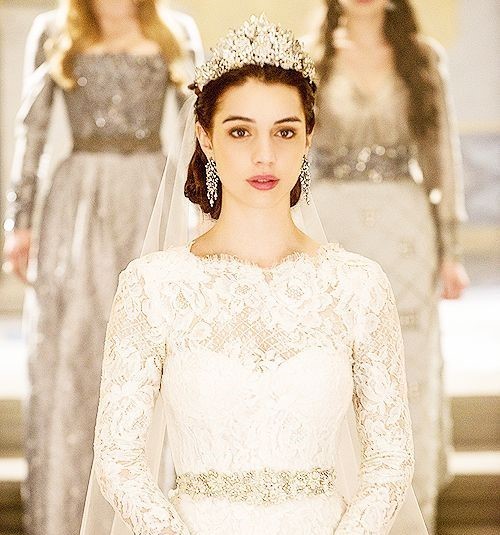
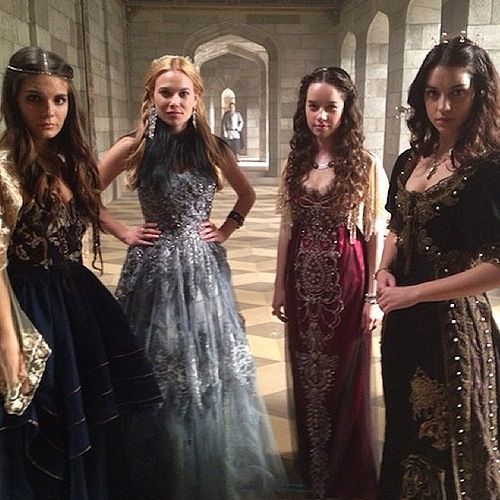

I've just gotta get this one out of the way. I made it through an almost-entire season of Reign before the atrocity that is its costuming got the better of me. If you'd shown me photos from this show without telling me it's about Mary Queen of Scots, I couldn't have guessed what period this might be set in. Reign's costume designer has stated "I wanted gowns that kept some kind of Elizabethan element, whether it was a nipped waist and extreme silhouette, or if it had a bit of a medieval feel" and uh. Yeah. By and large, that didn't happen. From what I can tell, a somewhat historical silhouette does begin to appear in the show's final season, but at what cost?
Perhaps Reign wouldn't have been as bad if the dresses were at least nice to look at. Instead, they're generally reminiscent of prom dresses - the fabric looks cheap, and the details look so tacky that I can't even endorse the costuming for this show from an aesthetic standpoint. Sorry to any Reign fans out there, but this is almost certainly going to be my most scathing review of the lot.
────────────
The Musketeers (BBC, 2014-16)
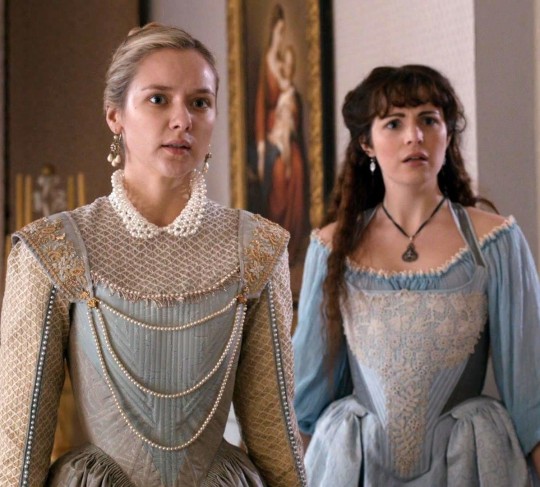

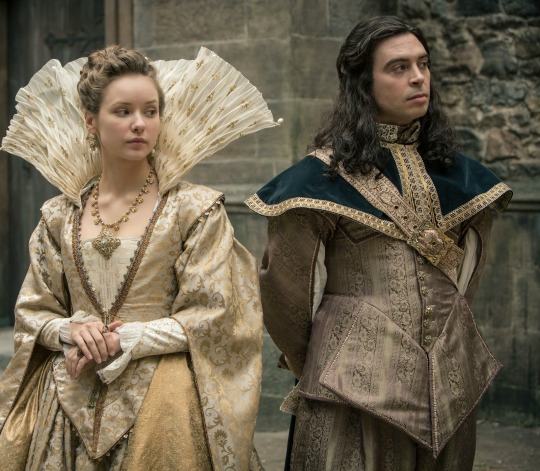
I love The Musketeers. I really do. But what the costume department was thinking - especially when it came to the women's costumes - I really have no idea. I mean, a Peter Pan collar?? On the Queen of France??? IN THE 1620S???? Truly something. Constance always looks like she only half-finished getting dressed that morning (why is her hair down. she's married.), and Anne sports some of the most outlandishly ridiculous collars I've ever seen. I don't even want to get into what Marie de' Medici is wearing. It's belts - as a necklace apparently! She also appears to be hiding some kind of gourd under her hair, but alas.
Yes, the men wear pleather. Yes, it does upset me.
The Musketeers' costumes perhaps wouldn't sting so badly if they didn't dress numerous background extras in significantly more accurate clothing. I've spent too much time watching this show and sighing in despair because Noblewoman Number 3 has a more accurate 1620s dress than the literal Queen.
────────────
The Spanish Princess (Starz, 2019-20)


I haven't properly sat down to watch The Spanish Princess through to its conclusion yet, but I do intend to - when she's not fawning over Richard III, Philippa Gregory adaptations can still be good fun, despite having about as much historical authenticity as the Fiji mermaid.
Nevertheless, no one in this show seems aware of what time period they're in, with dress styles spanning from early 14th-century surcoats to some fairly Elizabethan-looking silhouettes. The fabric choices are all over the place, and similarly - although not quite as egregiously - to Reign, often don't even manage to look good. Even from a modern standpoint, this show is colour- and pattern-clash galore. There is also practically no layering whatsoever, with the dresses going on as single pieces without a panel in sight. Admittedly probably easier from a production standpoint, but still.
Don't even get me started on the headdresses. Weird, pudding-cap-esque padded crowns and tiny scraps of fabric like the ones seen on Mary Tudor (an attempt at a French hood? I shudder) are fairly constant, although I have spotted a few passable attempts at a Gable hood.
They do get points for giving Arthur Tudor a fuck ass bob. Thanks.
────────────
The Buccaneers (Apple TV+, 2023-)


When I first started The Buccaneers and saw what its costuming had to offer, I audibly sighed. If you're a fan of visible back-lacing, cheap quality fabrics, and poorly fitting bodices, this is the show for you. The 1870s look is not a difficult one to emulate, and yet The Buccaneers fails rather miserably with its main characters, half of whom appear to be walking around in their underwear, with untied hair and single-layer dresses. Poor Nan only seems to own about two outfits that aren't visibly too big for her.
But by far the greatest crime committed by The Buccaneers' costume department comes in the decision to have multiple instances in which characters appear to be wearing corsets as tops. Yeah. I had a rough time with that one too. Mabel seems a particular victim of this - in both of the images above she looks as if she's been rushed out of the house before she got the chance to even button up her dress. A State of Affairs indeed.
────────────
The Good
Becoming Elizabeth (Starz, 2022)


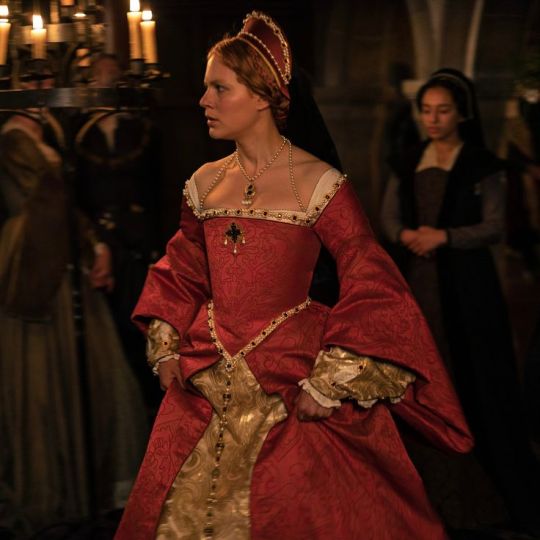
Although I was slightly underwhelmed with the execution of Becoming Elizabeth's story, this was absolutely overshadowed by its costuming, which is probably one of the most historically accurate depictions of Tudor clothing I've ever seen. With the same costume designer as Shardlake (which is also very well done - a big day for fans of Anthony Boyle's codpiece), it's remarkably clear how much research went into the pieces worn on this show, with some directly recreated from portraits, and others visibly inspired by surviving clothing from the period.
I won't pretend that Becoming Elizabeth's costuming is without flaws - I'm not a fan of Elizabeth's hunting/riding clothes, and she wears her hair down far too often (Catherine Parr appeared at times to have access to a Dyson Airwrap). However, the positives definitely outweigh any gripes I have. We have dressing scenes in which we see the separate layers and panels that comprised Tudor dresses, and the French hoods actually have hoods, as opposed to simply being the semi-circular headbands we see far too often. The royal women wear ermine fur on their sleeves, and I was also a fan of the jewellery.
The care that went into the costumes for Becoming Elizabeth is so clear - I truly wish I'd enjoyed the plot more, if just so that I could spend more time staring at those dresses.
────────────
Emma. (Autumn de Wilde, 2020)
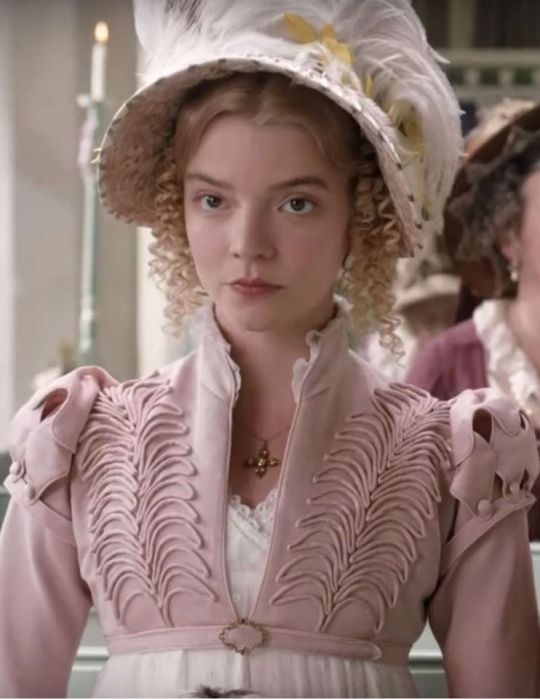


I adore Emma, and its costuming is honestly perhaps the biggest part of that love. The waistlines! The hairstyles! The bonnets! Emma's costumes are proof that you don't have to sacrifice historical accuracy for the sake of stylization - it's by far the most zany and colourful of any direct Austen adaptation, and yet its visuals remain strikingly faithful to the Regency period.
Like Becoming Elizabeth, many of the pieces worn in Emma bear a striking resemblance to surviving pieces and fashion plates from the era. The only problem I've noticed in this was the alarmingly strange detachable ruff-thing Emma is shown wearing in one scene, but frankly, it still manages to fit the tone of the piece.
I'm usually not a huge fan of the Regency fashion depicted on television - I find it rather dull - but the costumes in this movie are gorgeously distracting in every scene. Turns out historical accuracy actually can make things better - who knew!
Is this enough to make me forgive Alexandra Byrne for the costumes in Mary Queen of Scots (2018)?
No.
(I do not forgive ANYONE who worked on Mary Queen of Scots for making Mary Queen of Scots.)
────────────
Firebrand (Karim Aïnouz, 2023)

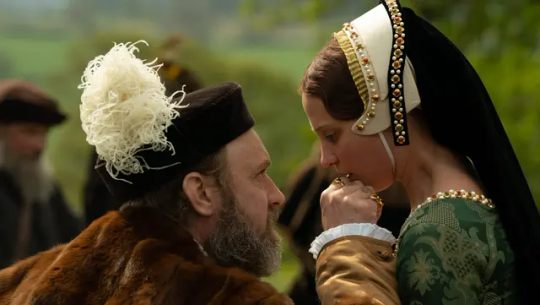
Firebrand hasn't even been released outside of Cannes yet, and already I am so, so down with everything it's giving. This movie could end up being the dullest two hours of my life, but I'll still sing its praises for one very simple reason - CHIN. STRAPS.
THAT'S RIGHT FOLKS!! The French hoods FINALLY have chin straps!!!! It's only been in virtually every well-known painting of them ever, no big deal.
Although we only have one trailer and a few promo photos to go off of, the costumes in Firebrand look fantastic, with enough layers, fur, embroidery, and hoop skirts to keep me happy for perhaps the rest of my life. We'll see how the movie itself turns out, but it already has a lot going for it in my eyes.
Also shoutout to Henry VIII's absolutely manky leg ulcers in the trailer. That's what I like to see.
────────────
The Outliers
Right. Here is where the hypocrite accusations are about to come flying. But frankly, I said it myself at the start that every period piece deserves to be judged on an individual basis, and the tone and intention of each piece is important in how its costumes are perceived.
That being said, if you think any of the 'bad' costumes deserve to be in this section - maybe they should've tried not being ugly, idk.
────────────
Bridgerton (Netflix, 2020-)


Bridgerton's excuse for its inaccuracy comes not from its lack of effort, but rather from its deliberate rejection of the historical narrative in any form whatsoever. We have two Real People™ in Queen Charlotte and King George III, but even their spin-off opens with a disclaimer that their story will be utterly fictional. Bridgerton does not present an issue like some of the other pieces on this list because it is actively opposed to being historically accurate to a degree that few other period pieces have arguably ever achieved.
Literally nothing about Bridgerton is consistent with history, so it does not disappoint when its costumes aren't either. The clothing does take visible inspiration from the Regency silhouette, but even then it is not consistent, with Queen Charlotte's costumes still firmly Georgian-esque (and honestly, marvellous wigs aside, they're not... bad?). Bridgerton is a historical fantasy before it's a historical drama, and as such it's easy to just sit back and enjoy the costumes for what they are - even when what they are is garish.
────────────
The Great (Hulu, 2020-23)

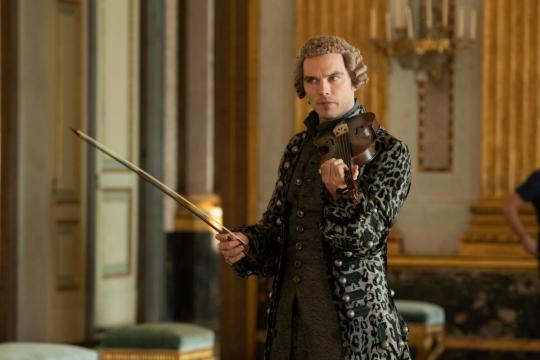

The Great is first and foremost a dark comedy, not a historical piece. Yes, Catherine the Great and Peter III were real people, and yes, much like in the show, Catherine did overthrow her husband in real life, too. But the similarities end here, as none of the characters in The Great have any intention of resembling their real-life counterparts.
Set roughly in the 1740s, the costumes in The Great are clearly far from reality, but they still resemble the silhouettes we know and recognise as 18th Century. The show is a satirical means of poking fun at the opulent aristocracy, and as such every costume conveys a distinct appearance of luxury. Every single item of clothing worn by the nobility looks absurdly expensive, and the exaggerated ridiculousness of many of the looks we see onscreen are an intentional way of conveying how utterly disconnected the people at court are from reality. From Peter's leopard skin jacket to ladies wearing powdered wigs as hats, The Great's costuming is purposefully elevated from its historical source material, and that is precisely what makes it so good.
────────────
The Favourite (Yorgos Lanthimos, 2018)


Sandy Powell's work on The Favourite is perhaps one of my all-time favourite pieces of costuming. Similarly to The Great, The Favourite utilises clearly recognisable aspects of 18th-century fashion - with ermine fur trim, half-length sleeves, and periwigs - but stylised so that everything conforms to a solidly black and white colour palate.
The Favourite's costumes are gorgeous and evocative of their time period - with well-portrayed mantuas, riding habits, fontanges etc. - all while conforming to Lanthimos' characteristically off-beat style. The shared colour palate really puts the three leads on equal footing in a visual sense, which is key in exploring the relationships that Abigail and Sarah are able to manipulate Queen Anne into developing. Had the colours and fabrics been historically accurate, I believe the movie would have risked making Anne too visibly above the rest of her court, but the striking congruence among the cast successfully solidifies their ability to exploit one another, regardless of status.
────────────
I don't know if there are any conclusions to be drawn from this, I just love talking. If you've made it this far - thank you for reading! I hope you found at least some of this interesting.
I'm always open and eager to discuss this topic, so please do let me know your thoughts - What are your favourite period drama costumes? What piece of costuming made you go OH JESUS WHAT IS THAT???
Anyway, thank you for going down this little rabbit hole with me - my asks are always open! <3
#history#period drama#period drama costumes#history posting#reign#the musketeers#bbc musketeers#the spanish princess#the buccaneers#becoming elizabeth#emma 2020#firebrand#bridgerton#the great#the favourite#historical fashion#historical costuming#costume design#helena has opinions
43 notes
·
View notes
Text

Silver Screen magazine, April 1939
And she did! But not until 1941
Also, the Marquis de la Falaise had previously been married to Gloria Swanson; she described him as the love of her life and helped smuggle him and his 3rd wife out of France during WWII

Constance Bennett & Gilbert Roland

Gloria Swanson & Henri de la Falaise
#constance bennett#connie bennett#gilbert roland#henri de la falaise#gloria swanson#hollywood#old hollywood#classic hollywood#vintage hollywood#silver screen#magazine#silver screen magazine#movie magazine#gossip#gossip column#1930s#1939#1941#1940s#1925#1920s
8 notes
·
View notes
Text
i'm a huge crybaby, so when my mom told me about the carmelite martyrs of compiegne, i thought to myself: i cannot be the only one who'll cry about it. which is why i'm sharing it now to you guys
so here's a little excerpt from an article that the Vatican published about it, along with some links about the entire thing:
Not too long after, Mother Teresa of St Augustine shared with the four oldest choir sisters with whom she lived a proposal to invite the entire community to offer their lives for the salvation of France, in imitation of St Teresa of Avila who reformed Carmel for that express intention. She understandably met with immediate resistance. After all, who in their right mind would voluntarily submit themselves to instant decapitation by the newly inaugurated guillotine? Remarkably, however, within the space of a few hours, the two senior nuns begged their Prioress’ forgiveness for their lack of courage. This opened the way for Mother Teresa to propose an act of self-offering to the other members of the community. As of November 27, each nun daily recited an act of self-offering for the salvation of France written by the prioress. Eventually, an intention was added for the release of those who had been arrested and that fewer people would be guillotined.
...
...the nuns’ voices singing the Divine Office floated through the streets of Paris as they were paraded toward the executioner’s block. The executioner also allowed the nuns to complete the prayers for the dying, which included the singing of the Te Deum. After the subsequent singing of the Veni Creator Spiritus, and the renewal of their vows, the nuns went one by one to the scaffold, received a final blessing from their Prioress, kissed a statuette of Our Lady, and followed the sacrificial Lamb.
Here's another quote, from a website named Devotion to Our Lady
Cloaked in their white mantles and with hands bound at their backs, the sixteen recollectedly boarded the tumbrils that would bring them to Place du Trône Renversé where the guillotine awaited them. Along the way, priests disguised as sans-culottes gave them absolution. The journey was long… but the air was permeated by their solemn chants of the sixteen, singing as they did in choir: “Have mercy on me, God, in your kindness. In your compassion, blot out my offense…. Hail, holy Queen, mother of mercy….” Before their execution they knelt and chanted the "Veni Creator", as at a profession, after which they all renewed aloud their baptismal and religious vows. The guillotine had been standing for more than a month already at the Barrière du Trône (Place du Trône Renversé; today it is called Place de la Nation). Upon arriving there, Sr. Constance suddenly accused herself before Mother Thérèse of not having finished her divine office. Her superioress told her: “Be strong, daughter! You will finish it in Paradise!”
you can read about it more here:
10 notes
·
View notes
Text
Happy 25th Anniversary Thracia 776
Credit to cainlawiet for this masterpiece

When I was trying to pick a flower for Leif to make Nanna’s flower crown with in Twofold Light, I was just looking for a flower that would convey he was thanking her for inspirating him. The flower crown was just meant to be a thank you present as Asbel’s had been. But when choosing a flower for Asbel, I didn’t just find one that meant gratitude but had more meanings that felt fitting for Asbel; constancy, everlasting love, connection and friendship. And this happened again with one of the flower I found in my search.
Irises have multiple meanings depending on the culture and their color. There’s also been meaning ascribed to the flower’s petals, the three being said to represent faith, valor, and wisdom. Faith is generally associated with healers but is also something Nanna is shown to have for Leif, enough for it to be the focus of her death quotes in both FE4 and Thracia. Nanna not only holds strong faith but doing so helps her inspire it in others, Leif admitting he wouldn’t have fought half as well without her keeping him from losing heart when their situation became bleak. He’s also shown to value her wisdom in their introduction in FE4, trusting and following her advice without hesitation. Valor is one of the first traits Nanna is shown to possess, chronologically, Thracia’s opening including a scene of her fighting one of the men attacking Fiana while the Freeblades are away and the first time she speaks in Thracia, she urges Leif to leave her to get to safety despite her life being actively threatened. It took her a while to become as bold and assertive as she is in FE4 but she has never lacked for courage or struggled to show it.
These aren’t the only meaning of irises that fit Nanna. Another commonly mentioned is positive change which Nanna helps spread and create even after the war. The flower shares its name with the Greek messenger goddess, making it a symbol of clear communication to them, and is also associated with messages specifically good ones in China and Japan, reminding me of Nanna carrying the letter than convinces Ares of the truth about his father’s death. Irises are also seen as having positive energy in Japan and China like Nanna does with her Charm skill. This positive energy is also seen as protective, irises being associated with protection since ancient Egypt and Nanna’s introduction being her protecting Fiana and Eyvel telling her to keep looking out for Leif in their reunion conversation, implying she has been since before their rebellion. The Egyptians also saw irises as symbols of power, the French agreeing so much the royalty adopted the fleur de lis, a ‘lily’ more likely inspired by irises, as their symbol, increasing the iris’s association with royalty and making it very fitting for a princess of a country based on France.
The more I looked into the iris, the more I realized I wasn’t just doing so to find the perfect flower for Leif to express what he appreciated about Nanna to her. I wanted to as well and not just with her. On the first day of spring following this, I posted my first flower thread on Twitter giving flowers to all the playable Thracia characters. I love Thracia’s cast, it’s my favorite of any Fire Emblem game, and choosing flowers for them was my way of trying to express that, to highlight what I appreciated and what made me so attached to each member of this cast. Thracia’s gotten a fair bit of criticism over the years for its cast, many characters not speaking after the chapter they’re introduced and three not speaking outside of their death and escape quotes. But I still love them and think Thracia did a fantastic job using the time they had to make as many of its characters as memorable as it could. It worked for and maybe just for me but that’s still enough reason for me to feel they deserve their flowers.
#fe5#fire emblem thracia 776#fe nanna#nanna#flower language#happy anniversary Thracia#this game means so much to me#I’d give it a whole garden if I could
10 notes
·
View notes
Text
A Cersei and Catherine de Medici Primer
So, if you’ve been following me at all recently, you’ll know I’ve been working on a fairy tale Cersei meta that I can guarantee will be disappointing after all the build up because I am a hack who just writes very slowly. Part of the Cersei meta involved a lengthy comparison with Catherine de Medici, that was about to consume the entire meta like some terrible eldritch horror, so I have been gently advised to make it a separate post. Which is what this is!
Comparing characters with historical figures is the basic bread and butter of the ASOIAF fandom, so I’m jumping on that wagon and riding it as far as it will take me, so without further ado, let's talk about Catherine.
Catherine lived from 1519-1589, but her most famous years are when she served as queen regent of France for her sons, which has often been called “the age of Catherine de Medici,” which is generally considered to be from 1559-1589, ending with her death.
Born in Italy, to the extremely wealthy, if technically common, merchant family of the Medici, Catherine was married off very young, at only fourteen, to Henry II of France (who was at the time the Duke of Orleans and the second son) by her uncle, Pope Clement VII. Her early years of marriage were extremely tumultuous, due to her being Italian in a time and place where that made her highly unpopular, her uncle dying before he could finish paying her dowry, and her inability to conceive for the first decade of her marriage. She was also famously not very attractive, and her in-laws often remarked that they could excuse her being Italian and poor if only she was beautiful. (The most common comments on her appearance were that she had the bulging eyes of the Medicis, and was very stout, but at least she had nice skin.) Of course, this is stands in stark contrast to Cersei’s famed beauty, but in many ways Catherine was just as defined by her appearance, only in the opposite direction.
One of the most famous on-screen depictions of Catherine is by Virna Lisi in the 1994 film La Reine Margot, based on the novel of the same name, in which Catherine is played with a near constance menace and severity (especially in contrast to the ethereal Isabelle Adjani as the titular Margot, Catherine’s daughter).
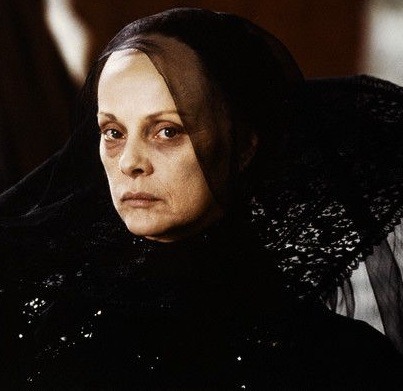
As the film goes on, Lisi’s features only become more exaggerated in their gauntness as the styling leans directly into every idea of the aging, wicked queen, as the true ruthlessness of Catherine’s actions are unraveled.
Just as Cersei is famed for her beauty, to the point of exaggeration that ultimately MUST fall short of the reality, Catherine skews the other direction, her ugliness the symbol of her internal wickedness, forever contrasted with her husband’s ageless beauty of a mistress.
I might even connect it to the raw exposure that Cersei feels during her walk of shame, her beauty, which she had always considered her greatest defense, stripped from her.
She did not feel beautiful, though. She felt old, used, filthy, ugly. There were stretch marks on her belly from the children she had borne, and her breasts were not as firm as they had been when she was younger. Without a gown to hold them up, they sagged against her chest. I should not have done this. I was their queen, but now they've seen, they've seen, they've seen. I should never have let them see. Gowned and crowned, she was a queen. Naked, bloody, limping, she was only a woman, not so very different from their wives, more like their mothers than their pretty little maiden daughters. What have I done?
-Cersei II, ADWD
"My wife has sweeter teats than those," a man shouted. A teamster cursed as the Poor Fellows ordered his wagon out of the way. "Shame, shame, shame on the sinner," chanted the septas. "Look at this one," a whore called from a brothel window, lifting her skirts to the men below, "it's not had half as many cocks up it as hers." Bells were ringing, ringing, ringing. "That can't be the queen," a boy said, "she's saggy as my mum." This is my penance, Cersei told herself. I have sinned most grievously, this is my atonement. It will be over soon, it will be behind me, then I can forget.
-Cersei II, ADWD
If a queen cannot be beautiful, what then is she worth? If she is beautiful, any myriad of sins can be forgiven, such as being poor or Italian, or heartless. (I will delve deeper into this theme in the meta proper.)
Catherine was also extremely in love with her husband, and was absolutely devoted to him. Her love was very unrequited, something that gave her a great deal of grief throughout the entirety of her marriage.
Through a series of mishaps and illnesses, Catherine’s husband came to the throne in 1547, and while Catherine was technically queen of France, all of her husband’s affections and many honours meant for his wife went to his long time mistress, the beautiful Diane de Poitiers. Although many years older than Henry, Diane held his heart until his death, and kept her looks as well, through a stringent routine of cold baths and exercise. The only thing that Catherine was able to give her husband that Diane couldn’t would end up being children. I might make a light connection from this aspect of Catherine’s life to Cersei’s, whose husband famously preferred a dead girl to her.
"I remember Robert as he was the day he took the throne, every inch a king," he said quietly. "A thousand other women might have loved him with all their hearts. What did he do to make you hate him so?"
Her eyes burned, green fire in the dusk, like the lioness that was her sigil. "The night of our wedding feast, the first time we shared a bed, he called me by your sister's name. He was on top of me, in me, stinking of wine, and he whispered Lyanna."
-Eddard XII, AGOT
Eventually, after years of trying various remedies and methods, Catherine was able to conceive, and had ten children in as many years, with seven surviving to adulthood. All of them would be sickly and frail (with the exception of her daughter Margot, also known as Marguerite of Valois), and she would outlive all but one of her sons (the last being stabbed to death eight months after she died), something that she spent her whole life trying to prevent. When her husband Henry died, Catherine went into permanent mourning, eschewing the traditional white mourning clothes of French queens for black widow’s weeds, earning her the moniker of the “black queen” in more ways than one.
(While Cersei does not particularly mourn Robert, she does take great joy in dressing for his funeral, a high-collared black silk gown, with a hundred dark red rubies sewn into her bodice, covering her from neck to bosom, and it is certainly an iconic look.)
One of the key parallels with Cersei is Catherine’s deep obsession with magic and the occult, that she would maintain for her entire life, patronizing astrologers and alchemists, including the famous seer Nostradamus. Her daughter Margot even claimed that Catherine had prophetic dreams about the deaths of family members, and would wake up screaming from them, sobbing out the name of the person who was soon to die. There were also extremely pervasive rumors that Catherine was an expert in poisons, which was a common stereotype for Italians at the time, and even today, you can visit a room in Chateau de Blois, with 327 little wooden drawers, rumored to have been used to hold all of Catherines’s various poisons (historians think it was likely to have housed her various art pieces and religious items rather than poisons). Catherine was rumored to have poisoned many of her enemies, using items like poisoned gloves. Even after her death, Catherine’s enemies claimed that she practiced witchcraft, and even created the first Black Mass (which is quite ironic, considering that all actual evidence points to Catherine being a devout Catholic who had grown up in a convent.) Interestingly, the events of AGOT are put in motion by a poisoning that Cersei did not commit, though it is assumed by pretty much everyone who is aware of how Jon Arryn died that Cersei did have a hand in it, since it is unclear whether or not Catherine actually did poison anyone or if it was mere rumor.
There’s even an extremely curious story about an enchanted mirror and Catherine, that is sometimes pointed to as the origin of the magic mirror in Snow White.
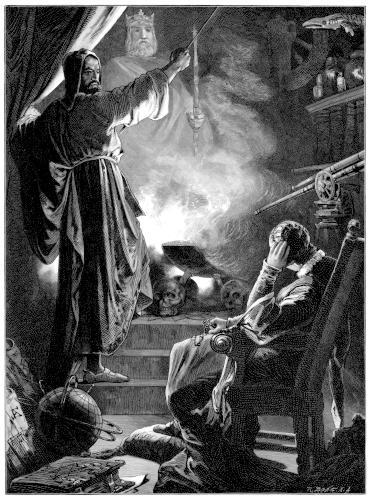
“Catherine de Medici in front of the magic mirror of her astrologer Cosimo Ruggieri” from Das Buch Fur Alle (1890), illustrated by unknown.
Supposedly, not long after the death of her husband, Catherine wished to know the future of the Valois dynasty and her sons, and summoned her astrologer Cosimo Ruggieri (in some later versions it is Nostradamus), to do so. Ruggieri produced a mirror, in some darkened chamber, and told her that the faces of the future kings of France would appear in the mirror, and the number of times each face circled the mirror would be the number of years that king would rule. Her eldest son, King Francis, faintly appeared in the mirror once before fading away. Then appeared her son, the future Charles IX, who circled the mirror fourteen times, followed by her next son, Henry III, who appeared fifteen times. After her son Henry’s face faded away, the Duke of Guise briefly flashed by, followed by the face of Henri de Navarre, heir to the Bourbon line, who would inherit the throne if the Valois line died out. Henri’s face circled the mirror twenty-two times, and Catherine knew her line would fail and Henri would be king.
Whether or not this particular story is true, Catherine did believe in the prophecies of astrologers and seers, who had correctly predicted that her husband would die in his fortieth year, and Catherine even dreamed of her husband dying violently the night before his fatal jousting accident. Further evidence added to her occult legend, is that Diane de Poitiers supposedly found pentagrams and other items used in magical rituals when she took custody of Catherine’s former palace, the Chateau de Chaumont. Needless to say, Diane never returned to that particular castle.
Like Cersei, part of Catherine’s myth is defined by a prophecy dooming her children that she tries and fails to avert.
Jo Eldridge Carney in “Fairy Tale Queens: Queenship and Power” makes an explicit connection between Catherine and the wicked fairy tale queen, drawing on a letter to Catherine from Jeanne de Navarre, mother of the same Henri who was prophesied by the mirror to supplant her sons.
“Fairy tales are replete with kind and gentle queens who are obedient and deferential to their husbands, devoted to their children, and beloved by their subjects. More memorable are the wicked queens who connive to seize power, manipulate their husbands and sons, threaten their daughters-in-law, compete with other women, and concoct all manner of horrific acts. When Catherine de Médicis invited Jeanne d’Albret to Paris in 1572 to discuss the proposed marriage of their respective children, Marguerite de Valois and Henri de Navarre, the Queen mother reassured her Protestant guest that she would be safe among the Catholics of the French court. Jeanne replied, “Madame, you say that you desire to see us, and not in order to harm us. Forgive me if I feel like smiling when I read your letters. You allay fears I have never felt. I do not suppose, as the saying is, that you eat little children.” Jeanne may well have been think- ing of the queen in Basile’s “Sun, Moon, and Talia,” who orders the cook to slaughter her husband’s illegitimate children and prepare them for his dinner. Similarly, the wicked queen mother of Perrault’s “Sleeping Beauty,” jealous of her son’s marriage, asks her steward to cook her grandchildren for her own dinner, even requesting a special French sauce to accompany the dish.”
Considering that later rumors would attribute the origin of the Black Mass to Catherine, which often included the ritual murder and consumption of an infant in a mockery of the holy communion, the link between cannibalism and evil queens being referenced in political conflicts dates back to the 16th century. (Part of my meta will explore Cersei’s own connection to cannibalism.)
Her eventual relationship with her future son-in-law Henri de Navarre would prove to be... complicated to say the least. It was rumored by many Huguenots (French Protestants) that Catherine had poisoned his mother, Jeanne de Navarre, using a pair of poisoned gloves, when Jeanne had come to Paris for their children’s wedding.
Any discussion of Catherine de Medici has to include the most infamous event of her entire life, which is where much of her black legend can be traced back to. On the 18th of August, 1572, after much political maneuvering, the Protestant Henri de Navarre married the Catholic Marguerite de Valois, in a wedding that many (but not all) hoped would put an end to the religious conflicts of France. Five days later, the Catholics would slaughter all the assembled Protestant wedding guests in the St. Bartholomew’s Day Massacre. Ordered by Charles IX after the failed assassination of the Protestant leader Admiral de Coligny, and lead by the fiercely Catholic and extremely powerful Guises, the massacre would spread across France, leaving 3,000 to 5,000 dead. Henri de Navarre would manage to survive by pledging to convert to Catholicism. The role of Catherine in orchestrating the massacre is unclear, but much of the blame is traditionally laid at her feat. There is evidence to suggest that Catherine had wanted a few of the most powerful Huguenot leaders killed but had never actually suggested a mass killing, and was shocked by the extent of what ended up happening, due to the religious powder keg that was Paris. But whether or not Catherine had actually approved of the massacre, it would remain a permanent stain on her reputation, and many of the most pervasive rumors about her poisoning and dark arts date to after the massacre, perpetuated by angry Huguenots.

“Catherine de Médicis with the Head of Coligny” by Joseph Hornung (1792–1870)
I might tentatively suggest that this event will parallel Cersei’s future destruction of the High Sparrow and the Tyrells. In the show, she straight up blew up the Great Sept of Baelor with all her enemies within, but in the books it may be a more traditional massacre, a bloodbath in the night as all gather for the trials of the queens, after the style of Catherine de Medici.
The rest of Catherine’s life would be a largely tragic one. She would see two more of her sons die, including her favorite, and would be estranged from her daughter Margot for the rest of her life, after imprisoning her when Margot’s husband, Henri de Navarre, escaped, even cutting Margot out of her will and refusing to speak to her. She did her best to keep France unified, but did not have the same influence and energy of her early regency. Her final son would only survive her by eight months. She died at the age of sixty-nine, of an unknown illness, having lost the love of her life who never returned her affections, and many of her oldest friends. Only days before her death, she had visited her old friend, the Cardinal de Bourbon, who told her, “Your words, Madam, have led us all to this butchery.”
And despite all her terrible deeds, both real and imagined, the most poignant epithet for Catherine is from her one-time son-in-law and prisoner, Henry de Navarre, who had become Henry IV, the new Bourbon king of France.
I ask you, what could a woman do, left by the death of her husband with five little children on her arms, and two families of France who were thinking of grasping the crown—our own and the Guises? Was she not compelled to play strange parts to deceive first one and then the other, in order to guard, as she did, her sons, who successively reigned through the wise conduct of that shrewd woman? I am surprised that she never did worse.
The actual extent of Catherine de Medici’s ruthlessness is debated, but her myth as true “Evil Queen” who worked with poisons and magic, orchestrating a religious massacre, certainly still survives and has influenced the trope deeply. Cersei as a character owes a deep debt to the legend of the Black Queen, Catherine Medici as much to the fairy tale stepmother.
Stay tuned for the first part of my Cersei meta, where I delve into her relationship to the tropes of the Evil Queen.
23 notes
·
View notes
Photo




Immediately after Falaise, the king had tried to limit Breton patriotism by remarrying his rebel son’s future mother-in-law, Duchess Margaret, to Humphrey IV de Bohun, Lord of Carentan in the Cotentin and constable of England. Margaret had likely been active in rallying support against Henry in the war, so the king could not trust leaving her in charge of his son and the heiress of Brittany, Constance. After the Bohun marriage, Margaret either chose or was not allowed to visit her daughter until sometime between 1187 and 1199, at least six years after the death of her second husband and possibly during the divorce of her daughter from her second husband Earl Ranulf III of Chester. Mother and daughter did not appear to meet again for at least thirteen years and when they did encounter each other it was on Breton soil at Jugon-les-Lacs, southeast of Saint-Brieuc.
-Melissa Pollock, The Lion, the Lily and the Leopard: The Crown and Nobility of Scotland, France, and England and the Struggle for Power (1100-1204)
29 notes
·
View notes
Text

I've decided since I'm already suffering this week, I need to keep on suffering. So I'm now watching this other MASTERPIECE that the Brits have deemed fit to gift us with during the pandemic.
This one boasts what is possibly the most British d'Artagnan I have ever seen? For some reason, it's told entirely in flashback.
Also, we're now pronouncing de Treville's name as.... wait for it ..... de TrevilLAY. That's right, Monsieur de TrevilLAY, who apparently traveled forward in time to serve Louis XIV, who has not yet been born.
The rest of my dying sobs under the cut!
Everything is very Choice! The font is really Celtic/Viking flavored. All the scenes seem to take place indoors because I guess this is very low budget.
Anyways, take a shot each time they say TrevilLAY. Just kidding, you would be dead in the first 5 minutes. Also, every conversation for some reason is much longer than it needs to be. Kept in mind, the entire masterpiece is only 1 hr 25 min long.
For some reason, Milady is a Spanish vixen with a very heavy accent.
Btw, here's the extremely historically accurate M. de TrevilLAY himself:
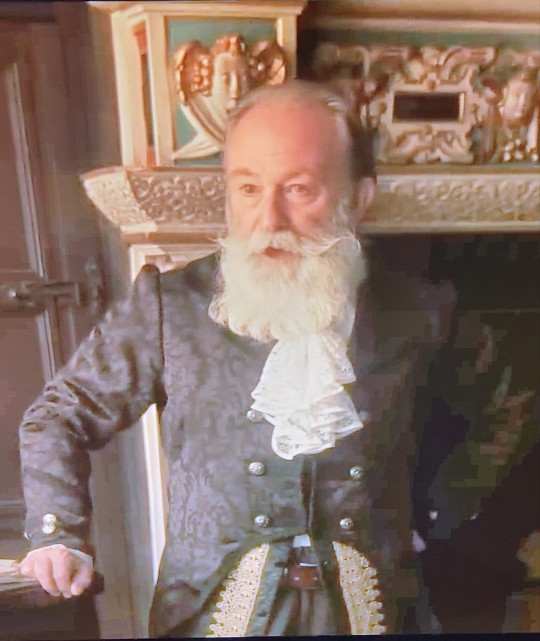
And these are our Dear Assholes:

Left to right, we have Aramis, Athos, and Porthos. At least these three are authentic assholes, which already makes this (rather long winded and boring) movie more fun for me than the French 2023 version!
Rochefort is here! For some reason he has a pronounced lisp, but I'm happy to see that unlike other adaptations featuring him, he has BOTH EYES in this version. The French 2023 version didn't even HAVE a Rochefort (rude).
d'Artagnan is a glorious idiot in this movie, like, so very dumb, he makes Chris O'Donnell's d'Art look like a genius.
OMG we're almost an hour into the movie and he hasn't even fought the duel with the 3 assholes yet! At this point, it's obvious the duel will never take place because it would have to be OUTSIDE, and, as I've mentioned, all the scenes take place INDOORS. 🤦🏻♀️
So the "plot" is that Milady has to seduce d'Art into coming to see Evil Lispy Rochefort so that Rochefort can recruit him to be the Cardinal's Double Agent.
In the meantime, apparently Athos and Porthos both have mistresses 😱😱😱 El Scandalo! TrevilLAY! Also Aramis now owes Porthos a crown because obviously they use British currency in France.
The extras in this movie are truly top notch! They just stand there and GLOWER. Not to spoiler the PLOT, but d'Artagnan is using cabbage as a weapon for purely British reasons.
Milady is TRULY PATHETIC in this version. I have no idea if she even knows Athos. She's basically like a combination of Constance and Milady in this? She's apparently FORCED into working for Evil Rochefort for Reasons, and now she's off on a dangerous mission in England, which we shall never know about because the movie is almost over 👀👀.
By the way, this

is the only fountain in Paris, and also how we're told that we're back in the "present" with Old d'Artagnan, since remember this is all told in flashback. And we must return to the pointless premise of the movie, which is that a young idiot (who looks like Tiny Thor) challenges Old d'Artagnan to a duel to prove himself worthy of being a musketeer.
Anyways, that's all they apparently had time for? It's incredibly pointless and I have no idea why they made this movie, other than maybe someone was really bored during the pandemic.
Lord help me, but I loved this stupid shit, if only because I am going to LOLSOB about M. de TrevilLAY forever and ever.
Grade: D+ as a movie, F- as an adaptation, A++ time stupidly spent
21 notes
·
View notes
Note
Hey can you make a monet de haan smut from gossip girl maybe a monet x fem reader and like monet gives reader a lot of gifts and then then smut
everything she wants

a monet de haan x reader
it's your birthday, and monet decides to make it extra special for you.
wc : 2.375
contains : fluff, most likely badly first-time written smut for someone who reads it all day. if ur cringing reading it im cringing writing it we'll suffer together <3 so yes fxf smut, oral with reader receiving.
a/n : ive never written like. actual smut so if this is bad im so sorry but thanks for the request lets do this gays. if savannah or the cast see my fics ill eat a battery.
.
when it came to you, monet was infatuated. she wouldn't say it out loud, minus the times some idiotic man thought he had a chance and tried to flirt with you, but everyone could tell.
.
.
they saw it in the way she defended you like her life depended on it, in the way she look at you when talking like you hung the moon and stars in the sky. she was the queen of constance and you were her consort.
so when the day of your birthday rolls around, you should have known she wouldn't hold back.
your day starts with the sweetest good morning text youve ever seen, sent to you from your one and only. monet wasnt one to show her affection through pretty words, but you could tell she tried just for you and that made it pull at your heart strings even more.
after eating a lovely breakfast and a giddy ride to school, you step out of your car with a farewell to your driver before seeing nearly a quarter of the school is still outside, flocking around something parked on the street. getting closer, you almost can't believe what you're seeing.
its a pop-up version of gâterie, your favorite place to go for the best pastries. but as far as you knew they only had locations available in france, so how was there...
"i found out they were deciding to open a pop up in the city and made some calls for their grand opening to be here." monet's smooth voice in your ear pops up from beside you, sending brief shivers down your spine. she wraps an arm around your waist before leading you forward, casually showing dominance like she loved to do.
she guided you up to the pop up, pushing and shoving other students out of your way, finally getting to the front of the line and monet getting your favorite pastry and drink before you could even process it. when you looked at her she just smiled and pulled you closer in to her.
"today's your birthday which means i don't want you to worry your pretty little head about anything, m'kay? now get your stuff so we can hurry to our seats, im already sick of standing near these lowlives and if that freshman keeps staring at us it's gonna ruin my good mood," she tells you, smiling bigger when you giggle at her meanness.
monet stuck true to her word the entire duration of the school day, making sure you didnt have to stress about anything. she tried to goad you into skipping with her to the spa so you didnt have to worry about your schoolwork, but stopped when you reminded her that not everyone's parents could snap their fingers and change their grades. you were lucky she liked it when you could go toe to toe with her bitchiness.
after school ended, she quickly whisked luna and you into her car without telling you where you three were headed, but by the look on her face, you knew it was somewhere good.
the car stops and you breathe out a sigh of relief when you look out of the window and see your favorite spa that you and the girls visit regularly. this was exactly what you needed after all the stress from the drama at school.
after a simple mani-pedi and a thorough massage, you walk into the lounging area where all the guests go after their stay and see monet hurriedly whispering something into lunas ear who then nods and walks away, holding her phone up to her ear and getting into what you can tell must be a passionate conversation.
monet looks pissed off until she sees you, putting on a slightly concerning but nevertheless welcoming smile as she wraps her arms around your waist and kisses you on both of your cheeks. which she always does when shes trying to distract you from something. hm.
"what are you hiding, sweetheart?" you question, nearly giggling when she smiles at your cheesy yet cute pet name for her.
"i despise when you call me that. and its nothing, just dealing with some morons for this school project im doing." her answer comes out smoothly, but you still feel slightly suspicious. youre confused why shed make luna go outside to take care of her presumably annoying classmates, but you decided not to worry about it too much.
after the spa, monet takes you to a high end boutique youve been checking the website for religiously to see when you could book an appointment. your look of shock and happiness is all monet wanted at this moment, pretending to be nonchalant when you turned towards her.
"dont give me that look. just buy and put on something pretty, ok? hurry up."
not wasting any time, you quicky flutter over to all of the clothes you see that catch your eyes: dresses, skirts, pantsuits. its a short search until you finally find the one outfit you like most, the one thats just perfect for you.
trying it on, you leave the dressing room to see monet sitting on the stool putside the curtain hurriedly putting away her phone, bringing back that suspicion you felt earlier. you dont get the chance to ask her what she was up to before she takes your arm and spins you, thoroughly observing the outfit you picked.
"if theres one thing i love about you its definitely your great sense of style." she tells, bringing her hands to your face and staring at you with that look that makes your heart flutter. "and your personality and all that, of course."
after checking out some more stuff you brought to try on, (and maybe making out for a few minutes but thats neither here nor there, also monet insisting you keep the outfit you liked most on), you get to the register and once hearing the price go to pull out your card before you hear a beep and whip your head to see monet smiling at you and putting hers away. you dont even get to comment before she grabs your bags and leads you back to the car.
a while into the drive, monet pulls out a blindfold from her bag and turns towards you. you try not to let the not so safe for work thoughts run through your head but by monets scoff and roll of eyes you can tell your reaction gave you away. you dont bother asking what its for, knowing she wont tell you anyway. you willingly put it on.
the car rolls to a stop and you feel monets smooth hands guide you out of the car and into the mystery building. its a short walk until she lets go of you for a moment, clearly opening a larget set of doors before leading you in further.
she moves behind you, pressing her body behind yours and slowly taking the blindfold off. the room she's taken you to is nearly pitch black, save for some lights on the far walls. your eyes are just starting to adjust when the lights turn on and your hit with a chorus of "SURPRISE!"
you're almost in a state of shock as you look around you, seeing a large crowd of your family, friends, and more standing and smiling at you. taking in the rest of your surroundings, you have to nearly stop yourself from jumping up and down, seeing that the place of your surprise party is the jane hotel, one of your favorite ballroom party locations.
"i'm gonna take your silence as one of pure happiness and adoration for your girlfriend who planned all of this for you." monet whispers, moving to your side and putting her hand behind your back to lead you forward to everyone else. "go say hi to to everybody, ill catch up with you later." and before you can even get a word in julien nearly flies into your arms, squeezing you near to death and telling you "happy birthday!" over and over.
the rest of the night is great, filled with drinks and food and dancing and reminiscing over old memories. its fun and sweet, but every so often youll catch monets eye, the girl seemingly innocently smiling at you to anyone else but you can tell when shes plotting, and it fills you with a sense of excitement.
eventually, the party comes to a close, guests saying goodbye and extra "happy birthdays" for good measure. monet comes up to you, taking your hand and wordlessly leading you out of the ballroom to her car waiting outside. after a few minutes of driving you recognize that its heading to your girlfriend's home.
"do you have another surprise for me?" you ask, smiling and leaning your head on her shoulder and looking up at her. every time you look at her it almost surprises you how damn pretty she is.
"it wouldnt be a surprise if i told you what it was, now would it?" she answers, bring her hand up to move some of your hair out of your face and resting it on your cheek. "dont worry. i promise youll love it."
"i know ill love it just like everything else today. thank you, by the way. it was sweet." you remove her hand from your face and bring it to your lips, giving it a few small pecks that she tries to act like doesn't affect her but you can see right past it.
"no need to thank me. you deserved all of it and it's my job as your amazing girlfriend to make it all happen." she hugs you closer to her, settling into her car seat as you do the same.
just when you feel yourself drifting off monet tugs you from your seat and up the stairs to her home, your mind drifting in between a state of semiconsciousness when you feel your bottom hit the familar soft padding of her bed, her sigh and tugging at your shoes bringing a light smile to your face.
"soooo wheres my last surprise of the evening?" your voice is soft, perfectly content with just sitting here in this moment with her.
"well, i might have worded it wrong. less a surprise ad more of a...reward." the tone of her voice and the feeling of her hands trailing up the sides of your thighs knocks the sleep straight from your brain. your eyes slowly open and follow to hers, the warm brown staring into you so intensely it feels like she can see into your soul.
“and what exactly am I being rewarded for?” you question, the words leaving your throat in a whisper.
she moves her body closer to yours, pushing you onto the bed and hovering over you. “because you're the best…girlfriend…in the world…and I want to show you how much i care about you.” she praises you into your skin, taking breaks between words to press a line of kisses up your throat until eventually, her lips meet yours.
there was nothing better in the world than monet’s kisses when she wanted you, they were just as intense as she was, and the feeling of the both of you combined lingered on your lips for hours after.
you feel like you're on cloud nine as she moves quickly yet softly, removing both of your clothing and pushing you farther up the bed as she kisses down your body. she presses harsh ones and teasing bites on your thighs, knowing how much you loved and hated it when she teased you. she smiled to herself when you started to squirm, deciding to stop teasing and give you what you want. and the sound of a ragged gasp leaving your lips when she connects hers to your core is one of her favorite sounds in the world.
she decides not to tease you for the rest of the night and you are all the better for it. the pleasure brought from her mouth and tongue combined with the comfort of your surroundings and mental state makes it feel like this is the best head you've ever gotten. granted you feel like that every time she does this.
she does everything she knows will drive you crazy, circling her tongue around your center, pushing it inside you along with using her fingers. it's slow but manages to hit you harder than anything else possible.
"monet..please, please i need to cum, don't tease." you moan, struggling to find the words with the constant attack on your sex.
monet just hums, continuing her attack on your cunt as she rakes her hands down your thighs, enjoying as you twitch and jerk your hips. "anything you want, baby."
the next few moments pass by in what feels like the longest minute of your life. she increases the speed of her tongue pressing into you and her fingers circling your clit in such a short span it causes your orgasm to hit you like a freight train, your hips raising off the bed and crying out "monet!" and "oh god, yes!" on repeat.
she continues her actions throughout it, keeping the same pace and motions until you start to flinch away from her and push her head. she gives your clit one last hard kiss before moving up to your face, kissing both of your cheeks before giving you another heated kiss.
"when you said 'a reward' you really weren't kidding," you joke, laughing when she rolls her eyes at you. "seriously, thank you. for everything you did for me today. it means the world to me."
the genuine smile on her face warms your heart, your hand coming up to her cheek to hold her in place and admire her. you press another kiss to her lips, this one being tender and slow compared to the ones earlier.
"mmm don't thank me yet," she pulls away from the kiss and sits in your lap, smoothing her hands up and down your arms. "we still aren't finished. tonight im gonna show you how much you mean to me, over and over and over."
happy fucking birthday to you.
.
.
.
i got this ask idek when and it took me so long to finish that now the shows cancelled im actually crying. but yeah this was my first time writing smut and to be honest. dont know how yall do it. but if you read hope this didnt make you wanna throw up <3
#monet de haan x reader#monet de haan#monet x reader#gossip girl reboot x reader#gossip girl x reader#gossip girl revival#gossip girl#gossip girl reboot#gossip girl 2021#julien calloway#luna la#ggrb#gghbo#monet de haan smut
105 notes
·
View notes
Text
an old connection found tim unaccompanied in paris yet again. when nancy peered around the room he'd acquired under a nom de plume, she mentioned quite casually that the painter cézanne stayed here; though she wasn't sure he historically ever Enjoyed paris. especially compared to aix - en - provence. aix had neglected the painter, but, "he was like its native son regardless."
then: "i think that phrase works better in france. did you get what i meant by that?"
he did.
。・゚゚・。・゚゚・。・゚゚・。・゚゚・。・゚゚・。・゚゚・。・゚゚・。・゚゚・
nancy was not in france on any sort of business. it did not matter if she was doing multiple sorts of business while there. it wasn't her intention to move around. it just sort of happened.
she showed up twenty minutes past their arranged meeting time and chatted absently about what she had been up to in the french riviera — lazy, dreamlike, gooey, tomatoes and olive oil and saltwater.
he drove her back down in a rented car, through the countryside, and she leaned her temple to the open window the entire time.
。・゚゚・。・゚゚・。・゚゚・。・゚゚・。・゚゚・。・゚゚・。・゚゚・。・゚゚・
her mother's townhouse was italian deco, though nancy warned him against saying anything of that nature. italy was france's evil twin, and vice versa.
tim called it Very Catalan instead, and laura was smugly delighted and agreed.
oliver the tomcat was big and orange and silent. tim scratched between his ears and was regarded with less of an ambivalence. oliver yawned at him. even the cat was dreaming.
。・゚゚・。・゚゚・。・゚゚・。・゚゚・。・゚゚・。・゚゚・。・゚゚・。・゚゚・
nancy spoke gorgeous french that tim couldn't keep up with. it was smooth and deep and chocolatey, and he understood it to be changeless from how she spoke her native english. she trained her mouth to be the same because it was important to her that french was not her mother tongue, but was her mother's tongue.
her quasi - european sentimentality, if you considered it, was actually very american. she took the basis and expanded on it and called it all hers. she had recent history and wide open spaces. she was free as a bird and deluded herself into thinking she was light as a feather. she had an old eyebrow raising polaroid that someone scribbled on, not her handwriting — THERE R MANY WAYS 2 FOLD THE FLAG — of which she ripped out of his hand and demanded him never to say anything about.
。・゚゚・。・゚゚・。・゚゚・。・゚゚・。・゚゚・。・゚゚・。・゚゚・。・゚゚・
laura beckoned tim outside where she kept three red gold hens who ruffled indiscriminately at anything as small to the slightest breeze, as if it disrupted their constant sleep.
«regardez,» she commanded of him, fresh eggs in her hands still covered in feathers, "see? i was a girl farming. constance is frightened of the chickens. they squawk to her, she at they. all my birds, very égoïstes. ç'est là."
that's that.
。・゚゚・。・゚゚・。・゚゚・。・゚゚・。・゚゚・。・゚゚・。・゚゚・。・゚゚・
on wednesday, children poured out of heavy doors at eleven in the morning in their uniforms in noisy rows before scattering amongst themselves down like ants. they dodged and weaved tim while he mindlessly walked down the rue droite. in his destroyed hand, a bitten pain aux raisins.
when he told nancy and her mother that he had, in lieu of not knowing much french at all, spoken in german to order, laura immediately approved of it as a smart decision. an american would have attracted too many questions and held up his time.
nancy's hand snapped out and took off an edge piece to pop in her mouth. "is that why you did it?"
no.
"yeah," he said anyway.
she watched his face.
he wasn't offended and didn't consider it a lack of skill in lying. it was as much in her nature to call it when she saw it as it was for him to play it as it lays.
。・゚゚・。・゚゚・。・゚゚・。・゚゚・。・゚゚・。・゚゚・。・゚゚・。・゚゚・
nancy cheek kisses her mother goodbye: Une Prochaine Fois, À L'Heure.
she says on the way to the airport that all french goodbyes revolve around time and hours. A Different Moment, To The Hour.
well, some things just work better in french.
floats her hand perpendicular to the asphalt out of the window.
A Land's Native Son, for one.
17 notes
·
View notes
Text
Round 1 is officially over!
Congratulations to the actresses who made it to Round 2!
Round 2 will begin on Saturday, May 4th
The winners of Round 1:
Maude Adams
Anna Maria Alberghetti
Julie Andrews
Angela Baddeley
Hermione Baddeley
Lauren Bacall
Olga Baclanova
Pearl Bailey
Josephine Baker
Lucille Ball
Anne Bancroft
Tallulah Bankhead
Theda Bara
Mona Barrie
Jessie Bateman
Polly Bergen
Claire Bloom
Mrs Patrick Campbell
Diahann Carroll
Lina Cavalieri
Helen Chandler
Geraldine Chaplin
Ruth Chatterton
Claudette Colbert
Constance Collier
Gladys Cooper
Katharine Cornell
Phyllis Dare
Zena Dare
Ruby Dee
Judi Dench
Stephanie Deste
Marie Doro
Geraldine Farrar
Maude Fealy
Edwige Feuillère
Susanna Foster
Trixie Friganza
Jane Froman
Eva Gabor
Zsa Zsa Gabor
Mary Garden
Greer Garson
Dusolina Giannini
Hermione Gingold
Dorothy Gish
Lillian Gish
Frances Greer
Mata Hari
Dolores Hart
Olivia de Havilland
Jill Haworth
Audrey Hepburn
Libby Holman
Lena Horne
Sally Ann Howes
Ethel Irving
Diane Keaton
Lisa Kirk
Eartha Kitt
Angela Landbury
Carol Lawrence
Vivien Leigh
Lotte Lenya
Beatrice Lillie
Bambi Linn
Gillian Lynne
Heather MacRae
Jayne Mansfield
Mary Martin
Jessie Matthews
Siobhán McKenna
Meng Xiaodong
Helen Menken
Ethel Merman
Cléo de Mérode
Evelyn Millard
Liza Minnelli
Rita Moreno
Odette Myrtil
Pola Negri
Julie Newmar
Nichelle Nichols
Maureen O’Sullivan
Aida Overton Walker
Anna Pavlova
Bernadette Peters
Lily Pons
Rosa Ponselle
Lee Remick
Diana Rigg
Thelma Ritter
Chita Rivera
Ginger Rogers
Lillian Russell
Rosalind Russell
Diana Sands
Lizabeth Scott
Maggie Smith
Emily Stevens
Susan Strasberg
Barbra Streisand
Yma Sumac
Inga Swenson
Laurette Taylor
Hilda Trevelyan
Monique Van Vooren
Fannie Ward
Ethel Warwick
Elisabeth Welch
Mae West
Anna May Wong
Diana Wynyard
Yoshiko Yamaguchi
8 notes
·
View notes
Text
Ages of French Princesses at First Marriage
I have only included women whose birth dates and dates of marriage are known within at least 1-2 years, therefore, this is not a comprehensive list.
This list is composed of princesses of France until the end of the House of Bourbon; it does not include Bourbon claimants or descendants after 1792.
The average age at first marriage among these women was 15.
Judith of Flanders, daughter of Charles the Bald: age 12 when she married Æthelwulf, King of Wessex in 856 CE
Rothilde, daughter of Charles the Bald: age 19 when she married Roger, Count of Maine in 890 CE
Emma of France, daughter of Robert I: age 27 when she married Rudolph of France in 921 CE
Matilda of France, daughter of Louis IV: age 21 when she married Conrad I of Burgundy in 964 CE
Hedwig of France, daughter of Hugh Capet: age 26 when she married Reginar IV of Hainault in 996 CE
Gisela of France, daughter of Hugh Capet: age 26 when she married Hugh of Ponthieu in 994 CE
Hedwig of France, daughter of Robert II: age 13 when she married Renauld I, Count of Nevers in 1016 CE
Adela of France, daughter of Robert II: age 18 when she married Richard III of Normandy in 1027 CE
Constance of France, daughter of Philip I: age 16 when she married Hugh I, Count of Troyes in 1094 CE
Cecile of France, daughter of Philip I: age 9 when she married Tancred, Prince of Galilee in 1106 CE
Constance of France, daughter of Louis VI: age 14 when she married Eustace IV, Count of Boulogne in 1140 CE
Marie of France, daughter of Louis VII: age 14 when she married Henry I, Count of Champagne, in 1159 CE
Alice of France, daughter of Louis VII: age 14 when she married Theobald V, Count of Blois in 1164 CE
Margaret of France, daughter of Louis VII: age 14 when she married Henry the Young King in 1172 CE
Alys of France, daughter of Louis VII: age 35 when she married William IV of Ponthieu in 1195 CE
Agnes of France, daughter of Louis VII: age 8 when she married Alexios II Komnenos in 1180 CE
Marie of France, daughter of Philip II: age 13 when she married Philip I of Namur in 1211 CE
Isabella of France, daughter of Louis IX: age 14 when she married Theobald II of Navarre in 1255 CE
Blanche of France. daughter of Louis IX: age 16 when she married Ferdinand de la Cerda in 1269 CE
Margaret of France, daughter of Louis IX: age 16 when she married John I, Duke of Brabant in 1270 CE
Agnes of France, daughter of Louis IX: age 19 when she married Robert II, Duke of Burgundy in 1279 CE
Blanche of France, daughter of Philip III: age 22 when she married Rudolf III of Austria in 1300 CE
Margaret of France, daughter of Philip III: age 20 when she married Edward I of England in 1299 CE
Isabella of France, daughter of Philip IV: age 13 when she married Edward II of England in 1308 CE
Joan II of Navarre, daughter of Louis X: age 6 when she married Philip III of Navarre in 1318 CE
Joan III, daughter of Philip V: age 10 when she married Odo IV, Duke of Burgundy in 1318 CE
Margaret I, daughter of Philip V: age 10 when she married Louis I of Flanders in 1320 CE
Isabella of France, daughter of Philip V: age 11 when she married Guigues VIII of Viennois in 1323 CE
Blanche of France, daughter of Charles IV: age 17 when she married Philip, Duke of Orleans in 1345 CE
Joan of Valois, daughter of John II: age 9 when she married Charles II of Navarre in 1352 CE
Marie of France, daughter of John II: age 20 when she married Robert I, Duke of Bar in 1364 CE
Isabella, daughter of John II: age 12 when she married Gian Geleazzo Visconti in 1360 CE
Catherine of France, daughter of Charles V: age 8 when she married John of Berry, Count of Montpensier in 1386 CE
Isabella of Valois, daughter of Charles VI: age 6 when she married Richard II of England in 1396 CE
Joan of France, daughter of Charles VI: age 5 when she married John V, Duke of Brittany in 1396 CE
Michelle of Valois, daughter of Charles VI: age 14 when she married Philip III, Duke of Burgundy in 1409 CE
Catherine of Valois, daughter of Charles VI: age 19 when she married Henry V of England in 1420 CE
Catherine of France, daughter of Charles VII: age 12 when she married Charles I, Duke of Burgundy in 1440 CE
Joan of France, daughter of Charles VII: age 12 when she married John II , Duke of Bourbon in 1447 CE
Yolande of Valois, daughter of Charles VII: age 18 when she married Amadeus IX, Duke of Savoy in 1452 CE
Magdalena of Valois, daughter of Charles VII: age 18 when she married Gaston, Prince of Viana in 1461 CE
Anne of France, daughter of Louis XI: age 12 when she married Peter of Bourbon in 1473 CE
Joan of France, daughter of Louis XI: age 12 when she married Louis XII in 1476 CE
Claude of France, daughter of Louis XII: age 15 when she married Francis I in 1514 CE
Renée of France, daughter of Louis XII: age 18 when she married Ercole II d'Este in 1528 CE
Madeleine of Valois, daughter of Francis I: age 17 when she married James V of Scotland in 1537 CE
Margaret of Valois, daughter of Francis I: age 36 when she married Emmanuel Philibert, Duke of Savoy in 1559 CE
Elisabeth of Valois, daughter of Henry II: age 13 when she married Philip II of Spain in 1559 CE
Claude of Valois, daughter of Henry II: age 12 when she married Charles III, Duke of Lorraine in 1559 CE
Margaret of Valois, daughter of Henry II: age 19 when she married Henry IV in 1572 CE
Elisabeth of France, daughter of Henry IV: age 13 when she married Philip IV of Spain in 1615 CE
Christine of France, daughter of Henry IV: age 13 when she married Victor Amadeus I, Duke of Savoy in 1619 CE
Henrietta Maria of France, daughter of Henry IV: age 16 when she married Charles I of England in 1625 CE
Louise Élisabeth of France, daughter of Louis XV: age 12 when she married Philip, Duke of Parma in 1739 CE
Marie-Thérèse, daughter of Louis XVI: age 21 when she married Louis Antoine, Duke of Angoulême in 1799 CE
21 notes
·
View notes